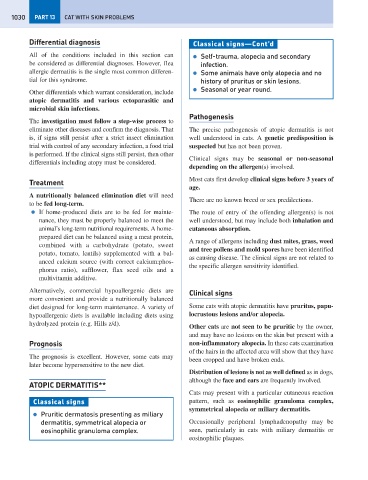Page 1038 - Problem-Based Feline Medicine
P. 1038
1030 PART 13 CAT WITH SKIN PROBLEMS
Differential diagnosis Classical signs—Cont’d
All of the conditions included in this section can ● Self-trauma, alopecia and secondary
be considered as differential diagnoses. However, flea infection.
allergic dermatitis is the single most common differen- ● Some animals have only alopecia and no
tial for this syndrome. history of pruritus or skin lesions.
● Seasonal or year round.
Other differentials which warrant consideration, include
atopic dermatitis and various ectoparasitic and
microbial skin infections.
Pathogenesis
The investigation must follow a step-wise process to
eliminate other diseases and confirm the diagnosis. That The precise pathogenesis of atopic dermatitis is not
is, if signs still persist after a strict insect elimination well understood in cats. A genetic predisposition is
trial with control of any secondary infection, a food trial suspected but has not been proven.
is performed. If the clinical signs still persist, then other
Clinical signs may be seasonal or non-seasonal
differentials including atopy must be considered.
depending on the allergen(s) involved.
Most cats first develop clinical signs before 3 years of
Treatment
age.
A nutritionally balanced elimination diet will need
There are no known breed or sex predilections.
to be fed long-term.
● If home-produced diets are to be fed for mainte- The route of entry of the offending allergen(s) is not
nance, they must be properly balanced to meet the well understood, but may include both inhalation and
animal’s long-term nutritional requirements. A home- cutaneous absorption.
prepared diet can be balanced using a meat protein,
A range of allergens including dust mites, grass, weed
combined with a carbohydrate (potato, sweet
and tree pollens and mold spores have been identified
potato, tomato, lentils) supplemented with a bal-
as causing disease. The clinical signs are not related to
anced calcium source (with correct calcium:phos-
the specific allergen sensitivity identified.
phorus ratio), safflower, flax seed oils and a
multivitamin additive.
Alternatively, commercial hypoallergenic diets are Clinical signs
more convenient and provide a nutritionally balanced
diet designed for long-term maintenance. A variety of Some cats with atopic dermatitis have pruritus, papu-
hypoallergenic diets is available including diets using locrustous lesions and/or alopecia.
hydrolyzed protein (e.g. Hills z/d).
Other cats are not seen to be pruritic by the owner,
and may have no lesions on the skin but present with a
Prognosis non-inflammatory alopecia. In these cats examination
of the hairs in the affected area will show that they have
The prognosis is excellent. However, some cats may
been cropped and have broken ends.
later become hypersensitive to the new diet.
Distribution of lesions is not as well defined as in dogs,
although the face and ears are frequently involved.
ATOPIC DERMATITIS**
Cats may present with a particular cutaneous reaction
Classical signs pattern, such as eosinophilic granuloma complex,
symmetrical alopecia or miliary dermatitis.
● Pruritic dermatosis presenting as miliary
dermatitis, symmetrical alopecia or Occasionally peripheral lymphadenopathy may be
eosinophilic granuloma complex. seen, particularly in cats with miliary dermatitis or
eosinophilic plaques.

